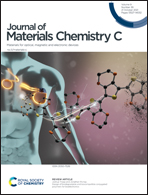Photo-induced negative differential resistance and carrier-transport mechanisms in Bi2FeCrO6 resistive switching memory devices†
Abstract
The new effects induced by light in materials have important potential applications in optoelectronic multifunctional electronic devices. In this work, double perovskite oxide Bi2FeCrO6 (BFCO) thin films were prepared by the sol–gel method, and the structural, optical, and electrical transport properties were investigated in detail. Good and stable resistive switching (RS) behavior with a large ROFF/RON ratio (>60) at a small voltage of 0.5 V can be realized. Interestingly, optical modulation conversion of the RS behavior and a negative differential resistance (NDR) effect induced by light were found in the Au/BFCO/FTO devices. Furthermore, the mechanisms of the RS behavior, NDR effect, and carrier dynamics induced by light for the Au/BFCO/FTO devices were discussed; the formation of oxygen vacancies was proposed to explain the good and stable RS performance, and the effective separation of photogenerated carriers can result in the NDR effect, which is further confirmed by transient absorption spectroscopy. The conversion of RS memory and the NDR effect have potential applications in optical modulation multifunctional electronic devices, electronic information, and optical quantum computers.



 Please wait while we load your content...
Please wait while we load your content...